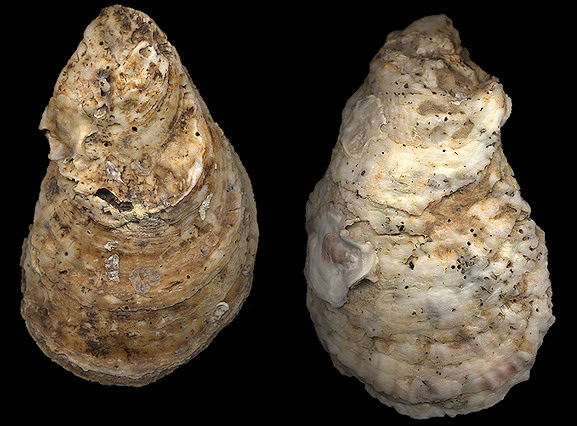But when did it start? With domesticated farming? The Greeks, Romans? There is no formal definition so it has commonly been considered the start of the Industrial Revolution - Crutzen was an expert on ozone, the scary atmospheric pollutant of the 1960s and '70s - but James Watt lived a long time ago and the Industrial Revolution doesn't excite anyone. One thing that believers in climate change share is a distrust in science like nuclear energy, so an international team has proposed making global warming more urgent by conflating it with the nuclear age. It also makes a little more sense since temperature readings from the early 20th century are not accurate and it reconciles with Crutzen's original belief since ozone also increased during that time.

Crassiostrea: a typical anthropocene fossil? Link: Welcome To The Anthropocene
An international working group has been trying to take the Anthropocene out of the marketing arena and formally making it part of science textbooks and they suggest that the key turning point happened in the mid-twentieth century, when there was a 'Great Acceleration' of population, of carbon emissions, of species invasions and extinctions, of earth moving, of the production of concrete, plastics and metals.
And they can't go wrong including nuclear power, when artificial radionuclides were scattered across the Earth, from the poles to the Equator, to be leave a detectable signal in modern strata virtually everywhere.
Dr. Jan Zalasiewicz of University of Leicester is chair of the working group and lead author of the proposal, which says that the beginning of the Anthropocene could be considered to start at the moment of detonation of the world's first nuclear test, which was July 16th 1945 and also firmly places the crux of the problem on American shoulders. They believe that nuclear science is the beginning of the new epoch because it meant a new energy source and a time level that can be effectively tracked better than something as fuzzy as CO2 or ozone.
Zalasiewicz says in their statement, "Like any geological boundary, it is not a perfect marker - levels of global radiation really rose in the early 1950s, as salvos of bomb tests took place. But it may be the optimal way to resolve the multiple lines of evidence on human-driven planetary change. Time - and much more discussion - will tell."
This year, the Anthropocene Working Group will try and make the case for the Anthropocene Epoch, including discussion of possible alternative time boundaries. In 2016, the group aims to make recommendations on whether this new time unit should be formalized and, if so, how it might be defined and characterized.
More information on the Anthropocene is available at:
http://quaternary.stratigraphy.org/workinggroups/anthropocene/
http://www.bgs.ac.uk/anthropocene/
Citation: Zalasiewicz, J., Waters, C.N., Williams, M., Barnosky, A.D., Cerreata, A., Crutzen, P., Ellis, E., Ellis, M.E., Fairchild, I.J., Grinevald, J., Haff, P.K., Hajdas, I., Leinfelder, R., McNeill, J., Odada, E.O., Poirier, C., Richter, D., Steffen, W., Summerhayes, C., Syvitski, J.P.M., Vidas, D., Wagreich, M., Wing, S.L., Wolfe, A.P., An, Z.&Oreskes, N. Published online. When did the Anthropocene begin? A mid-twentieth century boundary is stratigraphically optimal. Quaternary International. DOI: 10.1016/j.quaint.2014.11.045






Comments